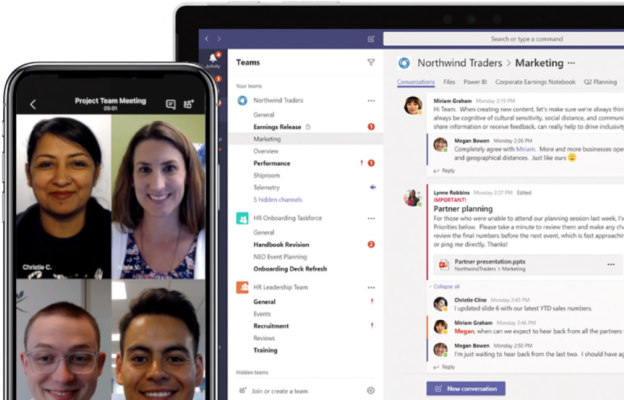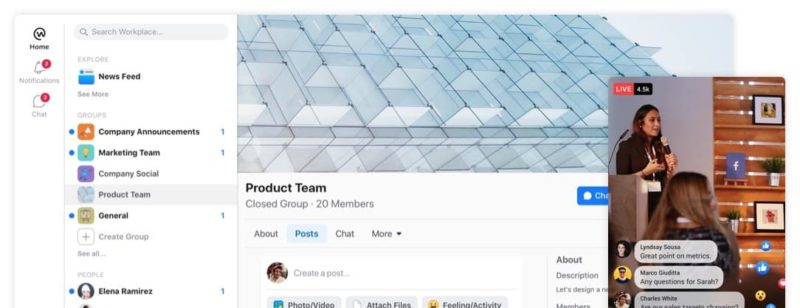Improve Productivity in the Digital Workplace
Microsoft Teams and Workplace by Facebook want to reshape the way we collaborate and stay productive in the digital workplace. Discover how you can benefit from these modern collaboration platforms. Choose the right one for your team to improve their productivity.
Business users feel increasingly overwhelmed by the flood of emails. More and more companies want to do without Excel spreadsheets and rudimentary office applications from the PC era. Classic intranets are an unreasonable demand for those used to the usability of modern devices and apps. In times of social media, smartphones and AI, communication and collaboration solutions are no longer sufficient to manage daily work.
With this in mind, modern business collaboration solutions are on the rise. They offer useful tools for planning, communication and productivity. They replace the good old e-mail and office programs, while opening new possibilities for effective collaboration in the company.
Improve Productivity and Collaboration in the Digital Workplace
From lean to-do apps such as Asana and Trello, which promise an easy entry into the world of business collaboration, to more powerful project management solutions such as Basecamp and Projectplace, which are available in countless variants and designs. And to modern social Networking for companies like Yammer or Chatter, as well as chat services for business teams like Slack or Troop Messenger, which are on the rise. Collaboration software market is becoming ever wider and is now difficult to understand. Further, organizations can also make use of employee monitoring software.
Microsoft and Facebook want to shake up this promising market. Global sales of business collaboration software are expected to be $8.4 billion by 2020. Both have recently presented promising products: Microsoft Teams and Workplace by Facebook. In the following, we present both solutions and describe their approaches and target groups. In addition, we deal with professional applications. Social intranets, enterprise social networks, and team collaboration apps now have to adapt to fierce competition.
Microsoft Declares War on Slack
Slack was catapulted into one of the most valuable business software startups. The growth figures that the startup shows are astonishing even for Silicon Valley conditions. Slack was able to win around 125,000 users and 13,000 teams as customers in the first six months after the official launch in 2011. And have announced that more than four million users are said to use Slack every day. It is remarkable that over 1.25 million users are paying customers.

However, Slack wasn’t the first chat service designed specifically for business teams. With HipChat, Atlassian is also a widely used chat tool for companies. It was very popular even before the first Slack release.
Over the years, both solutions have increasingly become the central information and communication hub for teams in companies. In addition to text chats and file sharing, they now offer other useful features for internal communication. Video conferencing, screen sharing and a powerful search function. And seamless integration options with numerous business apps and chat bots from third-party providers.
With teams, Microsoft is now expanding its product portfolio. This new tool competes directly against HipChat and Slack. At the end of 2016, it was presented as a preview version. Basically, the program has almost exactly the same feature set as its competitors. Slack reportedly wanted to make an $ 8 billion takeover bid last year, Business Insider reports. But Bill Gates personally broke the deal. Instead of spending so much money on Slack, the company should rather invest the money in the further development of its own productivity products in order to make them even more attractive for business customers. Teams appear to be one of the results of this strategy.
Seamless Integration with Office and Skype
Even if it looks like a copycat, Teams offers something that Slack and similar chat tools like Grape, Convo or Teamwork Chat can only dream of: Seamless integration with productivity tools that millions already used by people all over the world. Over 1.2 billion users in over 140 countries use Microsoft Office. Skype records up to three billion minutes of calls a day, many of them in the business environment.
Microsoft has integrated its new chat platform into the company versions of Office 365 free of charge. That clearly shows a key sales argument. All content, tools, contacts, and conversations are available in the Microsoft Teams work area. Users can simultaneously access the other, tried and tested productivity apps from Redmond, including the SharePoint intranet solution, the OneNote notes app and on Skype for Business to hold phone calls and video conferencing. Another decisive advantage: employees can edit Office documents directly in the application. Appropriate apps for iOS, Android, and Windows Phone are also available for mobile use.
Extensibility, Adaptability and Compliance in the Digital Workplace
As one of the largest enterprise software providers worldwide, Microsoft attaches great importance to adaptability and security for teams. Important factors that are among the most important purchase criteria, especially in the enterprise sector. Teams include extensible APIs (Application Programming Interface) to adapt to the digital workplace. Configurable tabs also offer quick access to frequently used documents. And make it possible to integrate third-party services, such as Asana.
In addition, Microsoft has integrated support for the Microsoft Bot Framework. This way, companies, as with Slack, can develop their own bots and integrate them into teams. As for security: Data is always encrypted. And it supports important compliance standards such as EU Model Clauses, ISO 27001, SOC 2 and HIPAA.
Workplace by Facebook
With Workplace, Facebook is entering the market for business productivity software for the first time. Put simply, the new communication platform offers an internal Facebook as we know it privately. The system does not need to be explained in this respect. And most users should be able to find their way around quickly.
With the familiar features, Workplace is easy and intuitive to use right from the start. It is important to note that in the business version there is no advertising and the data from personal accounts on Facebook and Workplace are completely separate from one another, the Zuckerberg Company assures.

Workplace makes a similar distinction between the actual app and the messenger. The so-called “work chat” in this context enables group chats, calls and video calls, as well as file and screen sharing. In this regard, it competes directly with Slack, HipChat and teams. As with the standard Facebook version, the new Facebook for companies lives primarily from the groups.
Administrators that manage these can be private or public. The entire internal communication in the company, but also the external communication with customers and partners can take place via such groups. These can include, for example, members of a specific specialist department, a location or a project team.
Social Intranets and Social Enterprise Networks
The product idea behind Workplace is not innovative or new. But on the contrary. Social networks for companies have been an issue in the business environment for years. The startup Yammer from San Francisco, which was launched in 2008 and was taken over by Microsoft for over a billion dollars four years later, has strongly coined the term “enterprise social network”. Since then, numerous comparable solutions have come onto the market, while classic intranets have been expanded to include components from social networks and have developed into “social intranets”.
Instead of focusing on business processes, the focus should be on people. Such systems primarily serve to improve internal communication and collaboration among employees with the help of features known from Twitter, Facebook and Co. IT giants like Oracle (with Social Network Cloud), SAP (with SAP Jam), Microsoft (with Yammer), Salesforce (with Chatter), VMware (with Socialcast) and Big Blue (with IBM Connections) are delivering themselves in this promising market segment a bitter struggle for years.
It is also interesting to note that many of these top players with their social software solutions no longer only address large companies, but increasingly also small and medium-sized companies. They confront with young startups that emerged in the cloud era and can outshine the large enterprise suites with innovative solutions. Last but not least, this includes solutions developed in this country such as Swabr, Coyo, Just Social, Xelos, and Tixxt, which have proven successful in practice.
Focus on Efficient Communication and Productivity
A crucial difference between Workplace and solutions like this is that the new Facebook for companies focuses exclusively on communication between employees and with the company’s external stakeholders. You won’t find any tools for project and task management, workflow optimization, or process automation that are often offered by social intranets and social enterprise networks at the Workplace. Even in areas such as document and knowledge management, solutions such as Tixxt, Xelos, Communote, and Co. can score points with additional features compared to the new Facebook platform.
Extensive all-in-one platforms such as Bitrix24, MangoApps, or Glasscubes provide not only the standard functions of an enterprise social network such as news feeds, profiles, and groups but also advanced modules for CRM, personnel management, project management, business intelligence, and other business applications. In doing so, they address companies, large and small, that want to bring business processes, collaboration, and employee communication under one roof.
Conclusion
With their new collaboration products for business teams, Microsoft and Facebook do not offer any particularly innovative or groundbreaking solutions that would revolutionize the market. But on the contrary. The respective features of the two products have been offered for years in widespread solutions by successful providers, which are already being used productively by millions of users. However, to describe Microsoft Teams and Workplace by Facebook as cheap copycats would be absolutely wrong. Because Facebook and Microsoft do not need brand new features to successfully assert themselves in the collaboration market.
Microsoft is one of the largest providers of professional productivity tools. The seamless integration of teams with Office and Skype, used by millions of users worldwide, is a unique selling point that is hard to beat. The massive user base of Facebook will also play a crucial role in the acceptance of the Workplace. Because almost every knowledge worker in the world knows how to use Facebook and will find his way around Workplace immediately. And when it comes to business software, user acceptance is key.
Tools to improve productivity in the digital workplace
- Collaboration tools
Asana, Trello, Basecamp
- Chat tools
Slack, Hipchat, Yammer, Chatter
- Productivity tools
Microsoft Teams, Workplace by Facebook